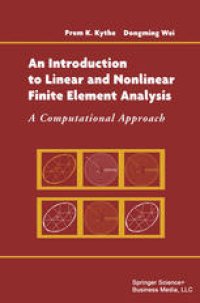
Ebook: An Introduction to Linear and Nonlinear Finite Element Analysis: A Computational Approach
- Tags: Applications of Mathematics, Computational Mathematics and Numerical Analysis, Partial Differential Equations, Theoretical Mathematical and Computational Physics, Appl.Mathematics/Computational Methods of Engineering, Engineering gener
- Year: 2004
- Publisher: Birkhäuser Basel
- Edition: 1
- Language: English
- pdf
Although finite element courses have become more popular in the undergraduate and graduate engineering, science, and applied mathematics curricula, there are very few introductory textbooks geared toward students accustomed to using computers for everyday assignments and research. 'An Introduction to Linear and Nonlinear Finite Element Analysis' fills this gap, offering a concise, integrated presentation of methods, applications, computational software tools, and hands-on programming projects. Suitable for junior/senior undergraduate and first-year graduate courses, the book is aimed at students from a variety of disciplines: engineering, physics, geophysics, and applied mathematics.
Unlike existing texts designed with specific applications to a particular field of mechanical, civil, or chemical engineering, the emphasis here is on interdisciplinary applications. One- and two-dimensional linear and nonlinear initial/boundary value problems are solved using finite element, Newton's, and conjugate gradient methods. Mathematical theory is kept to a minimum, making the text accessible to students with varied backgrounds.
Features:
* Software tools using Mathematica, Matlab, Fortran, and commercial finite element codes, such as Ansys, integrated throughout the text * Numerous examples and exercises with diverse applications to linear and nonlinear heat transfer, fluid flows, mechanical vibrations, electromagnetics, and structures * Supporting material and selected solutions to problems available at the authors' websites: http://www.math.uno.edu/fac/pkythe.html and http://www.math.uno.edu/fac/dwei.html * Minimal prerequisites: a course in calculus of several variables, differential equations and linear algebra, as well as some knowledge of computers
Primarily a classroom resource, the book may also be used as a self-study reference for researchers and practitioners who need a quick introduction to finite element methods. P>
Content:
Front Matter....Pages i-xxiii
Introduction....Pages 1-24
One-Dimensional Shape Functions....Pages 25-36
One-Dimensional Second-Order Equation....Pages 37-74
One-Dimensional Fourth-Order Equation....Pages 75-88
Two-Dimensional Elements....Pages 89-106
Two-Dimensional Problems....Pages 107-136
More Two-Dimensional Problems....Pages 137-174
Axisymmetric Heat Transfer....Pages 175-206
Transient Problems....Pages 207-240
Nonlinear One-Dimensional Problems....Pages 241-268
Plane Elasticity....Pages 269-296
Stokes Equations and Penalty Method....Pages 297-322
Vibration Analysis....Pages 323-350
Computer Codes....Pages 351-391
Back Matter....Pages 393-445
Content:
Front Matter....Pages i-xxiii
Introduction....Pages 1-24
One-Dimensional Shape Functions....Pages 25-36
One-Dimensional Second-Order Equation....Pages 37-74
One-Dimensional Fourth-Order Equation....Pages 75-88
Two-Dimensional Elements....Pages 89-106
Two-Dimensional Problems....Pages 107-136
More Two-Dimensional Problems....Pages 137-174
Axisymmetric Heat Transfer....Pages 175-206
Transient Problems....Pages 207-240
Nonlinear One-Dimensional Problems....Pages 241-268
Plane Elasticity....Pages 269-296
Stokes Equations and Penalty Method....Pages 297-322
Vibration Analysis....Pages 323-350
Computer Codes....Pages 351-391
Back Matter....Pages 393-445
....